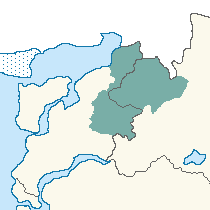Rianee Cooperative Reserve: Difference between revisions
Jump to navigation
Jump to search
mNo edit summary |
m Text replacement - "[[Glossary of peoples of Cusinaut" to "[[List of peoples of Cusinaut" |
||
| Line 9: | Line 9: | ||
}} | }} | ||
The Rianee Cooperative Reserve is a semiautonomous region composed of one province of [[Ashkenang]] and three provinces of [[Maloka]]. Founded in 2024 after the [[Final War of the Deluge]], it acts as a preserve for the seminomadic [[ | The Rianee Cooperative Reserve is a semiautonomous region composed of one province of [[Ashkenang]] and three provinces of [[Maloka]]. Founded in 2024 after the [[Final War of the Deluge]], it acts as a preserve for the seminomadic [[List of peoples of Cusinaut#Q-T|Rianee]] people, with Rianee tribes having preferential hunting and fishing rights as well as the right to apply tribal law and land rights protections. Its landmass is largely wooded hills and tundra. It is one of the poorest and most sparsely populated regions in both countries, particularly in Maloka. | ||
{{Template:Faneria}} | {{Template:Faneria}} | ||
Revision as of 10:26, 25 January 2022
Script error: The module returned a nil value. It is supposed to return an export table.
Rianee Cooperative Reserve | |
|---|---|
 | |
| Population (2025) | |
| • Total | est. 20,000 |
The Rianee Cooperative Reserve is a semiautonomous region composed of one province of Ashkenang and three provinces of Maloka. Founded in 2024 after the Final War of the Deluge, it acts as a preserve for the seminomadic Rianee people, with Rianee tribes having preferential hunting and fishing rights as well as the right to apply tribal law and land rights protections. Its landmass is largely wooded hills and tundra. It is one of the poorest and most sparsely populated regions in both countries, particularly in Maloka.